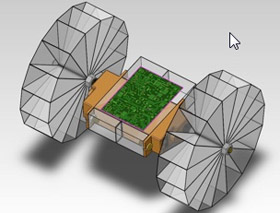Everything's Coming Up Robots at MIT [Videos]
-
-
slice.mit.edu
- 1
Filed Under
Recommended

A lot of MIT robots have been in the news recently. Take a look.
Origami-inspired This past summer, SEG, an origami-inspired Segway robot made of polyester, won third prize in the roaming category of a competition sponsored by the African Robotics Network (AFRON). The goal of the contest was to design robots that could easily be integrated into classrooms worldwide.
SEG consists of two large wheels and an IR sensor that allows it to avoid obstacles. It was created by members of the Distributed Robotics Lab, which is led by Professor Daniela Rus, director of MIT’s Computer Science and Artificial Intelligence Laboratory (CSAIL), as part of a $10 million grant from the National Science Foundation to reinvent how robots are designed and produced. The lab aims to create more affordable and accessible robots.
Unlike conventional robots, which can take weeks or months to assemble, SEG can be constructed in a day. Creases are etched into the polyester using a laser cutter. According to a CSAIL article, the circuit board, which contains all of the sensing and basic programming necessary for the machine to navigate, is also printed using a conventional printer to further reduce costs.
SEG is designed to be part of a kit. Students would then assemble the robot using only a screwdriver, soldering iron, solder, scissors, and tweezers, all for about $10. The team is already planning to send printable robot kits to classrooms in Africa in the near future.
Learn more on the project website and see SEG in action below.
Touch Sensitive The Boston Globe recently reported on Tactico, a robot design conceived at CSAIL by Eduardo Torres-Jara SM '02, PhD '07 and supervised by Professor Emeritus Rodney Brooks.
Tactico can pick up eggs or wine glasses just as easily as paper cylinders, and Torres-Jara hopes to enable it to perform fine-motor tasks, for instance using a pipette to transfer liquid lab samples. His start-up, Robot Rebuilt, which he cofounded with Paul Fitzpatrick PhD '03, is currently negotiating a technology license from MIT and seeking VC funding. See how Tactico works below.
Reconfigurable The milli-motein is a self-folding chain of programmable metal rings and strips that was inspired by naturally folding proteins. It was designed by Neil Gershenfeld, head of MIT’s Center for Bits and Atoms; visiting scientist Ara Knaian '99, MEN '00, MNG '00, SM '08, PhD '10; and postdoctoral associate Kenneth Cheung SM '07, PhD '12.
The News Office likens it to a Swiss-Army knife and says "the technology behind it, and the long-range possibilities it represents, are quite remarkable." Creators invented a new kind of motor—what they call electropermanent—that was small, strong, and held its position when switched off. Watch the video below and learn more in the News Office article.








Comments
Bill
Mon, 12/03/2012 3:32pm
Another related MIT robot concept is robotic American football. The intercollegiate competition has started at Notre Dame, and it was initiated by an MIT course 6 grad.
Overview:
http://www.youtube.com/watch?v=riCLMHQnWVc
Historic first foward pass:
http://cleveland.sbnation.com/2012/5/14/3019294/video-robot-football-ohio-northern-notre-dame
Come on MIT, take on the Irish!!